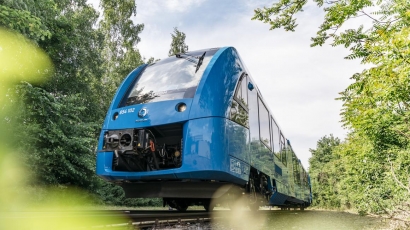
The Coradia iLint, built by Alstom in Salzgitter, Germany, is equipped with fuel cells which convert hydrogen and oxygen into electricity, thus eliminating pollutant emissions related to propulsion. Starting today, two such trains will enter commercial service according to a fixed timetable in Lower Saxony.
For the time being, it is travellers in EVB’s Elbe-Weser network who can look forward to a world-first journey on the low-noise, zero-emission trains that reach up to 140 km/h. On behalf of LNVG, the Coradia iLint trains will be operated on nearly 100km of line running between Cuxhaven, Bremerhaven, Bremervörde and Buxtehude, replacing EVB’s existing diesel fleet. The new trains will be fuelled at a mobile hydrogen filling station. The gaseous hydrogen will be pumped into the trains from a 40-foot-high steel container next to the tracks at Bremervörde station. With one tank, they can run throughout the network the whole day, thanks to a total autonomy of 1000 km. A stationary filling station on EVB premises is scheduled to go into operation in 2021, when Alstom will deliver a further 14 Coradia iLint trains to LNVG.
"This is a revolution for Alstom and for the future of mobility. The world’s first hydrogen fuel cell train is entering passenger service and is ready for serial production,” said Henri Poupart-Lafarge, Chairman and CEO of Alstom. “The Coradia iLint heralds a new era in emission-free rail transport. It is an innovation that results from French-German teamwork and exemplifies successful cross-border cooperation.”
Dr. Bernd Althusmann, Lower Saxony’s Minister of Economy and Transport, whose department has supported LNVG’s purchase of another 14 hydrogen trains with more than €81 million ($94.5 million) added,“The state government of Lower Saxony is proud of putting this trendsetting project on the track together with LNVG.”
The federal government has actively supported the development and testing of the new drive technology in Lower Saxony by providing funds from the National Innovation Program for Hydrogen and Fuel Cell Technology.
For LNVG chief Carmen Schwabl, whose authority organizes the rail passenger transport between the North Sea and the Harz mountains and therefore pays annual compensation of around €300 million ($350.2 million) to the railway companies, the entry to fuel cell technology is also a strategic decision. She sees LNVG in a national pioneering role.
With around two million rail passengers and around four million bus passengers per year, EVB figures among the largest mobility providers in the Elbe-Weser triangle. The traditional company, which boasts a history of more than 100 years and around 550 employees, is looking forward to the “train of the future”. Dr. Marcel Frank, Managing Director of EVB, emphasized, “It is a great milestone that we will use the world’s first hydrogen-powered train in our Elbe-Weser network in passenger service between Cuxhaven, Bremerhaven, Bremervörde and Buxtehude, not only for the region and for us, but also for passenger rail transport worldwide. For EVB, this is the entry to emission-free mobility.”

